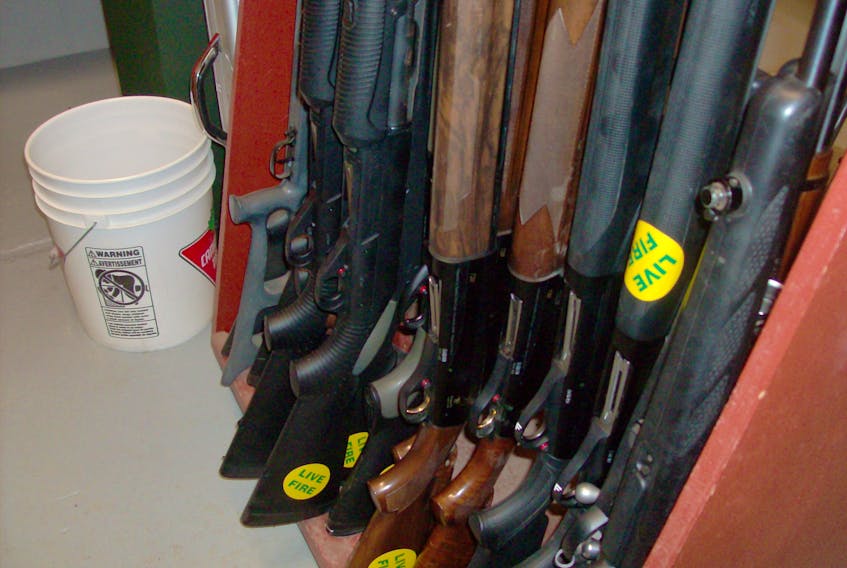A special report released Thursday by the province’s auditor general has revealed that at least 20 firearms have been lost — and possibly up to 30 more unaccounted for — in the wildlife division of the Department of Fisheries and Land Resources going back a number of years.

A RCMP investigation into the missing firearms concluded no evidence of criminal activity.
Auditor General Julia Mullaley’s report was completed in response to a request for an audit one year ago from the provincial government. The request came a couple months after the wildlife division was realigned with the Department of Fisheries and Land Resources from the Department of Environment and Climate Change.
Mullaley’s report acknowledges that the department has already taken necessary actions — many implemented during the course of the audit — to improve inventory management and security of firearms and ammunition in the wildlife division.
There are a number of recommendations to further improve the system.
“We found a lot of weaknesses with respect to record-keeping,” Mullaley said. “For example, the inventory system was not up to date, it wasn’t accurate, it wasn’t complete, it was missing information.”
One issue was that the division requires a Wildlife Division Asset (WDA) number to be assigned to each firearm upon acquisition. As of October 2017, there were 30 WDA numbers that could not be accounted for in the inventory system.
“The department did a lot of work to try to determine that, and part of the issue was that there were practices in the past where those asset numbers were assigned to non-firearms such as pellet guns, replica guns and starter pistols,” Mullaley said.
“We found a lot of weaknesses with respect to record-keeping. For example, the inventory system was not up to date, it wasn’t accurate, it wasn’t complete, it was missing information.” — Auditor General Julia Mullaley
“But we don’t know. It is a possible answer to it, but it is not a definitive answer. And at the end of the day, no one could account for the 30 number.”
Other than those 30, there were 20 firearms determined to be lost and they have now been reported to the federal gun registry as such. Another six firearms were recorded at the federal registry, but they could not be found in the inventory.
“Under the federal legislation, any acquisitions or dispositions or any lost items, stolen items, anything like that has to be reported to the federal registry,” the auditor general noted.
The whole issue came to light following a regular internal review of inventory processes in March 2017 by the Department of Fisheries and Land Resources. The internal review determined there were anomalies in inventory control.
As of October 2017, according the division’s inventory system, there were 476 firearms in the inventory. That number included 158 functional firearms, 294 non-functional firearms (used for educational courses throughout the province), 13 firearms without functionality classification and 11 firearms listed as being lost.
There were discrepancies and inaccuracies found in the numbers and so Mullaley’s office was asked to conduct a formal audit into policies and procedures.
The RCMP was also asked to have a look, but Mullaley said the audit and the police investigation were separate.
“The main objective was whether the department had an effective system of controls in place around management and safeguarding of the inventory on firearms, specifically around the wildlife division,” Mullaley said. “The department itself had identified some concerns and it was on that basis that they asked us to come in.
“The main theme was around the lack of internal controls. For example, they did not have any comprehensive policies for inventory management, which are very key when you are in any inventory management process.”
The report noted that there are inherent risks associated with inventory management including inaccurate inventory records, loss, theft and inappropriate or unauthorized access to and use of inventory.
Some other issues of note in the report include that four personal firearms belonging to an employee had been stored at the wildlife division storage facility in Brake’s Cove — there is no formal policy regarding the storage of personal firearms.
There was uncertainty about who had a key to the firearms room at one of the storage facilities. To address those concerns, the department changed the access code to the secured room within the facility that contained the firearms room, and also changed the lock to the firearms room.
The kits containing non-functional firearms and dummy ammunition, used to deliver the Canadian Firearms Safety and Hunter Education courses, were found to have one combination code for all cabinets and firearms kits throughout the province. A commonly used code reduces intended security features.
Key recommendations say the department should:
• Establish and communicate comprehensive policies and procedures to guide staff in the acquisition, disposition, recording, storage, use, movement and monitoring of firearms and ammunition;
• Ensure the inventory system is complete and accurate by updating information on a timely basis and maintaining transaction history;
• Ensure the Federal Firearms Registry is updated on a timely basis;
• Ensure the secure access to, and storage of, firearms and ammunition;
• Consider segregating custody and record keeping duties of staff involved with firearms inventory;
• And develop an oversight framework for monitoring inventory management processes.
Fisheries and Land Resources Minister Gerry Byrne said his department supports the recommendations.
“Having the divisions of enforcement, forestry and wildlife, which all require the use of firearms, under the new Department of Fisheries and Land Resources, assisted in a more rapid assessment of the challenges faced, and enacting an effective solution,” Byrne said.
“As the auditor general also notes, further efforts are necessary to ensure the department has an effective system of internal control to safeguard firearms and ammunition, and those efforts are either fully completed or well underway.”
Byrne noted actions taken as a result of the audit, including:
• Consistent firearms policy applied across the department; development of new departmental policy is in progress.
• Firearms control assigned to the compliance division, Enforcement and Resource Services Branch, to ensure the safeguarding and protection of firearms.
• Firearms ammunition kept in acceptable storage throughout the province, with site-specific combination locks being implemented.
• All ammunition scheduled for destruction has been destroyed in accordance with policy.









